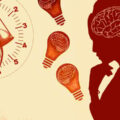Mental Illness As Brain Energy Deficiency
The February 3 issue of Time magazine had an entry entitled “When Every Day is a Mental Health Day”. The Blue Cross Blue Shield Association reportedly found that in people between the ages of 24 and 39 in 2020, depression is the fastest-growing health condition. Fainting attacks, known as syncope, reportedly occur in 15-39% of the general population when they suddenly stand up from a chair.
It was also reported from Kaiser Permanente that “depression is a leading cause of illness among young people and anxiety is on the rise. Suicide ranks third as a cause of death for 15 to 19 year olds”. It is interesting that a picture of a young woman is shown whose anxiety level is described as medium-high. Her favorite pick-me-ups are described as “hugs, candy, conversation”. This is the cryptic message that invokes the methods which she uses to calm herself in the face of stress. Yes indeed, it is true that candy is often used as a kind of solace for the misfortune of stress.
I will show that far from helping an individual to adapt to stress, candy is often the underlying cause of the depression and anxiety that represents maladaptation to the stresses of daily life.
Stress: Anything That Demands a Physical or Mental Response
I turn to the work of Hans Selye who proposed that human diseases were the “diseases of adaptation”. Hans Selye was a Hungarian medical student. He was in a class where the professor was bringing patients into the classroom to describe the disease that was diagnosed in each of these individuals. Selye was not listening to the professor. He was engaged in looking at the facial expressions of each of the patients as they were brought in. He came to the conclusion that the facial expression was similar from patient to patient, irrespective of the disease that was being described, that they were all suffering from the stress of the disease, irrespective of its diagnostic category. He immigrated to Canada and set up an institution in Montréal to study the effects of stress. Of course, he was unable to study this in humans so he inflicted physical trauma to rats by the thousand and did laboratory studies to show the effects. He found that the laboratory showed changes in the blood that were similar to those found in human beings afflicted with chronic illness. He formulated his findings under the heading of “the General Adaptation Syndrome” and labeled human disease as “the diseases of adaptation”. The remarkable conclusion was that the resistance to whatever was responsible for causing the disease (stress) required huge amounts of energy in the brain for the process of adaptation. I am suggesting that the vulnerability of the American population is because so many people are unable to adapt to the everyday incidents encountered in just living.
This of course makes a world of sense because infections, trauma and prolonged mental pressures such as ugly divorce or business assignments (stress) are known to initiate disease and sometimes even death. At the time of Selye little was known about the way that the body manufactures the energy derived from food so his conclusion was the mark of genius. He actually did recognize his own genius and firmly believed that he would be the central figure in 21st century medicine. I believe that he could have been right but his work has been largely ignored for at least two reasons. The cruelty to animals got him into trouble with the antivivisection league and the pharmaceutical industry captured the field.
Energy and Illness
We now know a great deal about the way this energy is produced and consumed in the body to produce function. The conclusions of Selye now make perfect sense in analyzing the cause of human disease. The only change that I would make would be to call human diseases “the diseases of maladaptation” because Selye pointed out that succumbing to stress was nothing more than the failure of energy production in adapting to whatever form of stress was being imposed. In order to understand this, you have to remember that infection, trauma, and problems involving mental work all come under the dominant heading of stress and that they all demand consumption of mental energy in the solution by adaptation.
Thus, we can begin to see that disease, irrespective of diagnosis, is nothing more than a combination of genetic risk coupled with a failure to meet the energy demands required. The initiation can be represented by the integrative action of one or more of three interlocking circles labelled Genetics/ Sress/Nutrition. There is now evidence that most genetically determined disease, including cancer, does not usually produce disease on its own. For example, diabetes is genetically determined but does not develop until middle age and often following a “stress event” such as an infection, trauma or a prolonged and nasty divorce. We have to recognize that the body’s ability to manufacture sufficient energy to meet whatever stress is imposed comes from the quality of the food. A relatively new science is called epigenetics and is the study of how our genes can be affected by nutrition and lifestyle.
I know that I am repeating myself (for emphasis) when I write that the ability to adapt to any form of physical or mental stress depends on brain/body energy and that if bad news, injury, infection or a nasty divorce, has to be faced in the modern world, Selye would point to the need for brain energy in meeting and adapting to that stress. Of course, if we are healthy, the adaptation is automatic and we don’t even think about it. In short, we adapt. That has given rise to the idea of “good, and bad, stress”. However, if a person becomes sick at such a time we are most unlikely to think of it as mild to moderate brain energy deficiency. Without this, the brain “complains by initiating symptoms”. In other words, individuals developing mental disease have biochemical deviations in their ability to adapt. Depression and anxiety are merely examples of the way in which the brain shows energy failure, the result of simply being alive. Note that depression and anxiety are perfectly normal as we adapt to the appropriate stimulus. They are abnormal when they exist chronically for no apparent reason or stimulus. The underlying mechanism has been exaggerated and is a reflection of abnormal brain function.
The January 2020 issue of National Geographic magazine states that “stress plays a major role in many illnesses that kill us. It also drives unhealthy eating, poor sleep, alcohol and drug misuse, and other bad habits. Modern medicine really sucks (their word) at preventing chronic disease”. In the same issue, “food allergies have become so widespread that many schools restrict what kind of lunch kids can bring from home for fear of setting off a classmate’s allergic reaction. Oddly enough, allergy is a brain sensitivity, resulting in abnormal organ action, so it is in reality brain related. For example, a woman who was known to be allergic to rose pollen enters a room where there is a bowl of roses. She succumbs to an attack of asthma that requires hospitalization, only to find later that the roses were artificial. The point is that the asthma could be initiated by more than one sensory input.
In the United States 5.6 million children suffer from food allergies. This translates to two or three in every classroom”. I will illustrate the unifying concept of energy deficiency by discussing a number of diagnoses in which the medical literature supports it.
Energy and Brain Autonomic Function: Parkinson’s and Alzheimer’s Diseases
The classic prototype for dysautonomia is beriberi, the vitamin B1 deficiency disease. Although this is not by any means the only cause of energy deficiency in the brain, it acts as a model for clinical expression. To put it as simply as possible, it represents an unbalanced ratio between calories ingested and the density of the micronutrients contained in the food source that catalyze the complex mechanisms of energy production. For example and contrast, the diet in Okinawa, Japan, that boasts a high concentration of centenarians, is nutritionally dense, meaning that it contains the vitamins and essential minerals that enable the calories to be burned (oxidized). It is also calorically poor, while in the US it is the reverse and where chronic disease is common. It has been shown in animal studies that a calorie poor diet correlates with the prolongation of youthful activity and even life itself.
In this presentation, I will try to show that brain energy deficiency is the major cause of disease. Because the controls of the autonomic nervous system in the lower part of the brain are quickly affected by energy deficiency, (the commonest cause in America is TD) it is not surprising that dysautonomia is common and occurs as part of other diagnostic categories. What I mean by that is that many diseases have been described in the medical literature associated with dysautonomia. For example, Parkinson’s and Alzheimer’s diseases are in a group of conditions that have a causative relationship. Both are associated with dysautonomia.
Megadose thiamine treatment has been reported to be successful in Parkinson’s disease.This information comes from a physician in Italy and it amply supports the concept that this chronic disease is caused by brain energy deficiency. The importance of the word megadose means that thiamine is not simply replacing a dietary vitamin deficiency. It is being used as a drug. The multiple actions of thiamine are all known to be essential in energy synthesis. If two diseases such as Parkinson’s and Alzheimer’s have a common cause, you might well be asking how is it that they are different in character? I think that this is an extremely important point. The disease in the brain depends on the distribution of the deficiency and hence the function of the affected cells. There is always symptom overlap in the two diseases. Variations in the presentation of disease can be extraordinarily variable.
Panic Disorder, Autonomic Dysregulation, and Energy
Supposedly psychological in nature, it is really a sympathetically initiated fight-or-flight reflex, originating because of brain oxygen, or oxidation, deficiency. The association between panic disorder and cardiovascular disease has been extensively studied. Some of these studies have shown anxiety disorder co-existing with or increasing the risk of heart disease. Heart disease almost always occurs in vitamin B1 deficiency beriberi, because the heart functions continuously throughout life and requires a continuous supply of energy. But heart disease occasionally does not occur, depending on the severity and the cellular distribution of the deficiency.
Recent interest has focused on whether some modern heart disease is caused by energy deficiency. What is confusing to people is that tachycardia (accelerated heart), occurring for no specific reason, is caused by an erratic signal from the brain via the autonomic nervous system. If the heart muscle is also deficient, the autonomic signal may result (for example) in atrial fibrillation. The treatment would therefore be energy stimulus in both brain and heart. This is why beriberi, the disease that is the well accepted result of vitamin B1 deficiency, causes defective function in the controls of the autonomic nervous system and the heart as the commonest result of this disease.
It also raises eyebrows when I say that beriberi is common in America, but is unfortunately not recognized by physicians whose overall philosophy is that “any sort of vitamin deficiency simply never occurs in America because of vitamin enrichment of foods by the food industry”. The trouble with that philosophy is that the extraordinary ingestion of empty calories in this population overwhelms the vitamin dependent machinery that oxidizes the calories. The best analogy that I can offer is a choked car engine. The input of gasoline must match the capacity of the spark plug to initiate gasoline ignition.
Overall, results suggest that rates of epilepsy are elevated among individuals with panic disorder and that panic attacks are elevated among individuals with epilepsy. An article reviewing the causes of epilepsy includes recent reports on the effects of inefficient cellular use of oxygen as a causative factor. Hyperventilation (over breathing) occurred in 25% of a group of patients with a relatively common form of dysautonomia (POTS) associated with fainting attacks. The authors hypothesized that the hyperventilation in this condition arises because of brain hypoxia.
This is supported by the fact that people prone to panic disorder are known to develop one of their attacks when situated on the top of a mountain. One of my patients was an elderly lady who indulged in square dancing once every two weeks. Invariably she would develop a feverish illness lasting several days after returning home. Without going into the complex details I was able to conclude that her energy requirement was increased by the physical effort required for square dancing. Because her energy synthesis mechanism was depleted from thiamine deficiency, these episodes of fever were exactly similar to the condition called mountain sickness. With megadose thiamine she was able to continue her square dancing without suffering these repeated illnesses. This patient’s problem could not have been addressed by the orthodox assumption that each episode of illness was due to an infection; Because of a rigid concept that these recurrent episodes were only the result of an infection, we tend to forget that the “illness” is really an exhibition of the complex mechanisms of defense organized by the brain. Lacking in a full complement of energy, its organizational capacity is depleted.
Many examples of manuscripts appearing in the medical literature describe the presence of multiple diseases occurring in a single patient. We suggest that this stretches credibility because we cannot predict the incidence of one disease in a person, let alone the incidence of two or three at the same time. Rather we should be seeking a single causative factor to explain all the symptoms. In the reports of multiple conditions occurring in one individual, one of them is invariably described as dysautonomia, strongly suggesting that the cause in common is brain energy deficiency affecting the controlling mechanisms.
Energy Deficiency and Health Across Generations
Mental illness, including depression, anxiety and bipolar disorder, accounts for a significant proportion of global disability and poses a substantial social, economic and health burden. Treatment is presently dominated by pharmacotherapy that averts less than half of the disease burden and is purely treatment of symptoms. In the January 2020 issue of the National Geographic under the heading of “A World of Pain”, a case is described of a pregnancy in which the patient called Karen “begins bleeding profusely so is taken to the operating room, where doctors perform a hysterectomy. After the operation, she suffers multiple organ failure and has a cardiac arrest from which she does not recover. Karen dies of pre-eclampsia”. This is a high blood pressure disorder that is unfortunately all too common in pregnancy. I recently learned from a book written by an American Ob/Gyn specialist that this kind of tragedy could be completely prevented by the initiation of a megadose of thiamine routinely given daily during the pregnancy. It is indeed stunning to claim that pregnancy complications are all manifestations of beriberi and that this cheap and simple ingestion can prevent all pregnancy complications, a fact that most people would find hard to believe.
But this also makes sense. The food that the mother ingests must be able to provide the energy, not only for herself but for the rapidly growing infant that she has to support. It is no surprise to me that dietary indiscretion by the mother, such as the use of alcohol and the lunacy of smoking, provides a legacy to her yet unborn child that adds to the burden of child development both before and after birth. It is now well known that sudden death syndrome in infants can be a legacy of the pregnancy. Breast milk thiamine deficiency has long been known to be responsible for sudden death in a breast fed infant and breast fed infants are associated with a higher risk of autism in our modern world.
What about other nutrient deficiencies as a cause of disease? People suffering from depression, schizophrenia and dementia often have measurably lower levels of serum folate compared to people not experiencing psychiatric disorder. Even the use of methyl folate, an important part of the chemistry of folate, as a stand-alone monotherapy has been observed to exert antidepressant properties. Earlier in this presentation, I mentioned that sugar was the cause of anxiety, not a treatment for it. The fact is that the processing of sugar is extremely complex and can initiate energy deficiency in the brain. Obviously, energy deficiency represents a threat to the organism and so there is an automatic initiation of the sympathetic nervous system that results in the fight-or-flight reflex. In other words, under these circumstances the initiation of this reflex is because the sugar has caused thiamine deficient pseudo-hypoxia. The obvious safety measure, automatically governed by the brain, is to alert the organism to the perceived danger, however that interpretation or brain misinterpretation might arise.
Brain Energy Deficiency and Violence
There is a link between mental illness and firearm violence, reported to be a significant and preventable public health crisis. Hypoxia and hypercapnia (too much carbon dioxide in the blood from inadequate breathing) excite the sympathetic branch of the autonomic nervous system. Excitation of this system generates the fight-or-flight reflex that is associated with aggression. Pseudohypoxia (imitates true hypoxia) is caused in the brain by thiamine deficiency. Therefore, there should be a serious look at the diet history of gun violence perpetrators.
Early Diet and Behavior
Many years ago, when I was in practice as a pediatrician, I saw many children who were brought because of emotional disease such as hyperactivity, learning disability, unusual temper tantrums and sleep problems. The current and false explanation for this was poor parenting, but on discussion with the parents I found that in almost every case the parenting was perfectly healthy. The diet of these children was appalling, however, very high in empty calories, particularly as those from sweets and I began to keep records of the dietary mayhem that was so common. In many cases I measured the intake of carbonated beverages in gallons per week. When I instructed the parents concerning an appropriate diet for their children, the emotional symptoms disappeared. This was so impressive and the children’s response to drugs so unpredictable, I decided to practice what has become known as Alternative Complementary Medicine. Please note that complementary is spelled with an ‘e’ not an ‘i’ and it indicates that it strives to take the best of orthodox medicine and complement it with the use of nutrients that represent the elements essential to energy metabolism. The two physician organizations that have developed are the American College of Advancement in Medicine (ACAM) and the International College of Integrative Medicine (ICIM).
We Need Your Help
More people than ever are reading Hormones Matter, a testament to the need for independent voices in health and medicine. We are not funded and accept limited advertising. Unlike many health sites, we don’t force you to purchase a subscription. We believe health information should be open to all. If you read Hormones Matter, like it, please help support it. Contribute now.
Yes, I would like to support Hormones Matter.
Photo by karatara: https://www.pexels.com/photo/male-statue-decor-931317/.
This article was published originally on February 24, 2020.
















I suffer from hereditary Cyclothymic Disorder. My father oscillated between diagnosed ranging from BPD to Bipolar Disorder ( I can’t recall if it was type 1 or 2). I have recently been weaned off of my psychiatric medications due to neurological side effects . I was recently diagnosed with spinocerebellar ataxia , this is compounded with the fact that I had a cerebeellar stroke in 2003. The cyclothymic disorder is my primary concern is the cyclothymic compounded with an atrophied cerebellum. This leads to occasional innaproproate outbursts and saying inappropriate things. I had serious issues when I was younger, primarily concerning my mental issues. Do you have anything you have written or direction, as far as nutrients, etc. that might help balance brain chemicals or help ataxia patients who also have psychiatric issues?
Read all the thiamine posts on HM and see if it applies
Dr. Lonsdale, your articles are very interesting. I’ve read nearly every article of yours on thiamine.
I wondered if you’ve encountered a child like my son. He’s age 11 and has had speech clarity issues since he began talking. He also has always been behind his peers with basic motor skills – throwing, catching, etc. And, seems to have some form of hypoxia. He couldn’t maintain his stamina while playing with friends. His conditions led me to think it might be a thiamine deficiency.
After slowly ramping up TTFD to 100mg/day (and supplementing with magnesium) his hypoxia lessened somewhat. But, his speech and motor skills didn’t improve.
Now, I’m trying 300mg/day of thiamine HCL (ramped up slowly). That seems to somewhat help with the speech clarity and possibly with motor skills.
I’ve read the account of a young child who needed 600mg/day. Should I continue increasing the thiamine? What else would be worthwhile trying?
He’s a good student and well liked by peers.
And by the way, his older brother by 3 years has seen a noticeable benefit from thiamine. He has very good oral presentation skills, but would stammer and stutter when nervous. 100mg/day of thiamine has remedied that. Although, he has very skinny limbs. Could that be a thiamine deficiency too?
Thank you for any insight you can offer.
I have panic disorder with agoraphobia, but not on any medications for it.
Have you had any patients that you used thiamine megadosing to treat their panic disorder? Would there need to be any need to be any kind of specialized dosaging or protocol for using thiamine therapy to treat panic disorder?
Mainstream medicine really only recognizes cognitive behavioral therapy and/or lower dose SSRI medication as beneficial methods for treating panic disorder despite both of these methods apparently not working for 20% of people, and/or the end up relapsing back into the disorder.
Personally I’ve tried out using Ecological Formula’s allithiamine for a number of months and can’t say I noticed anything too profound; although the highest dose I got up to with that was around 300mg/day. I was thinking of giving it a go with thiamine hcl and working up to high doses 2-4 grams.
I’m curious to know if you have any further opinions regarding panic disorder and treatment of it.
Thanks!
Yes, but often times it will take months before there is change and it to titrate up to a sufficient level to initiate change. Remember though, magnesium is also needed, as are the other Bs and vitamins and minerals.
Dr Lonsdale, I’d be interested to know whether you’d class MCT oils, which I know are often used in medical nutrition, as a possible contributing factor to the problem of ’empty calories’? I personally have noticed improvements in energy and cognitive function with using MCT oil, but also an increased need for some nutrients eg zinc and calcium.
MCT is not the preferred fuel for the brain. It still has to be oxidized. I prefer natural foods that contain a full complement of micronutrients, especially thiamine.
Thank you!
Dr.Lonsdale,
My wife has had so called “alarm headaches” for almost 10 years, i.e. she is awakened by a headache she cannot ignore every night at around 2-4 AM. It is quite severe and it about about an hour to get rid of it by dosing with various modalities including chi machine, infra red heat, laser and what always helps is coffee.
She started on the Lipothiamine 100mg with magnesium taurate and when she increased to 150 mg her headache went away for 5 nights but now it is back.
Should she increase again?
You mention that the use of thiamin is not to be considered a vitamin deficiency but as a drug application and that megadosing is recommended. Since she is using the more bio available form of thiamine Lipothiamin is there some way of knowing how much she is getting compared to say thiamin HCL or Thiamine mononitrate? That is if she is taking 150 mg of Lipo would that be considered a mega dose of another type of thiamin
An interesting question. I was struck by the use of coffee at 2-4 am. The probable answer may surprise you. Thiamine stimulates energy production while coffee causes energy consumption. Try leaving off the coffee with present dose of thiamine. If that is not the answer, increase the thiamine. I presume that you are also using a magnesium supplement. The headache at that time is evidence that the brain is temporarily out of energy for an obscure reason. You might check on the post that deals with sleep energy.
We increased the Lipothiiamin to 200 mg, 2 in the morning, 1 in the evening and 1 at bed. She has slept beautifully for 3 nights.
The first night she had what she refers to as a heart shock, i.e. like a bowling ball rolling through her system and wham her heart gets hit. It is scary indeed but it calms down and we attribute it to the paradox. It has happened before and somehow seems to be attributed and coupled with the weird alarm headache.
She is so happy to be sleeping!
As a side light I woke up a while ago with vertigo. What a strange feeling. I am now up to 100mg Lipo and the verigo disappeared like a switch being turned off. Thank you
Dr. Lonsdale.
The good nights lasted for 2 nights and now she is having rapid heart rate, pressure on the chest, and wanting of air. Also the headaches are back somewhat, enough to be bothersome.
She is taking 200 mg Lipothiamin. 125 magnesium taurate, B comples 100 and a very healthy diet.
We were wondering now that we are peeling the onion , if biotin or folate or potassium ate advisable or some other ingredient!
Thank you in advance
You will NOT correct these long standing problems quickly. You have to work through paradox and have patience. This is not a “quick fix”
Thank you again for the great article, I really enjoy reading them.
I wonder what your insight is regarding taking nicotinic acid with b1(lipothiamine)
I know you recommend taking a b complex, which I do, but personally I notice better memory retention, reduced anxiety/irritability, better concentration and less dizziness after eating, especially empty carbs.
Would you think it’s related to pseudohypoxia? No clue if pseudohypoxia was the reason for the feeling of holding my breath and not getting air all the time, but it reduced at an impressive level.
No problem; it is nearly as important as thiamine, but thiamine deficiency seems to be easy to acquire and is probably the commonest form of deficiency. In practice I always added B complex and magnesium to the patient’s nutrients. If you study the cause of beriberi it is thiamine that pops up.